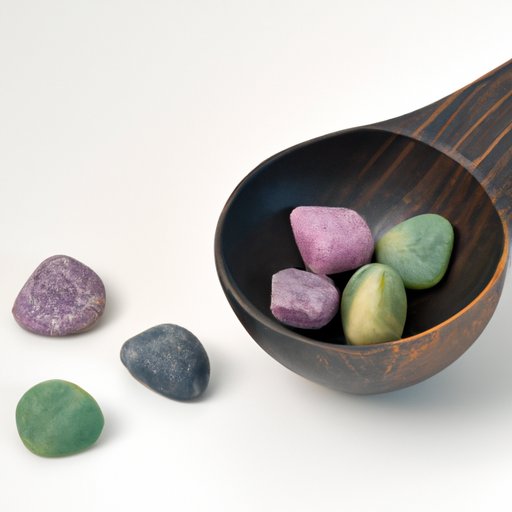
I. Introduction
Tonsil stones, medically known as tonsilloliths, are small, foul-smelling calcified deposits that can form on the tonsils. For some people, these stones can cause bad breath, a sore throat, and difficulty swallowing. Fortunately, there are several effective ways to remove tonsil stones at home. In this article, we’ll explore five of these methods as well as tips for preventing tonsil stones from forming in the first place.
II. 5 Effective Methods to Remove Tonsil Stones at Home
There are several methods you can try at home to dislodge tonsil stones:
Method 1: Using cotton swabs or Q-tips
You can dislodge small tonsil stones using a clean cotton swab or Q-tip. Gently press on the tonsil and apply pressure to push the stone out. Be careful not to apply too much pressure that can cause your tonsils to bleed or become sore.
Method 2: Gargling with salt water
Gargling with saltwater can help loosen tonsil stones that are stuck. Mix 1/2 to 3/4 teaspoon of salt into a warm glass of water and gargle for about 30 seconds. Spit out the solution, and repeat as needed.
Method 3: Using a water pick or oral irrigator
A water pick or oral irrigator uses a jet of water to remove tonsil stones. Aim the water at the tonsil stone to dislodge and remove it. Be sure to read the instructions and use the gentle or low-pressure setting to avoid irritation and damage to the tonsils.
Method 4: Removing tonsil stones with a clean finger or tongue scraper
You can also use a clean finger or the rounded side of a tongue scraper to gently dislodge tonsil stones. Apply gentle pressure to push the tonsil stone out. Remember to clean your hands and tongue scraper before use.
Method 5: Combinations of the above methods
You can also combine different methods to dislodge tonsil stones more effectively. For example, you can gargle with salt water to loosen stones and then use a cotton swab to dislodge and remove them.
III. The Art of Prevention: Tips to Stop Tonsil Stones from Forming
Tonsil stones form due to a buildup of debris, mucus, and bacteria on the tonsils. Here are some tips to stop tonsil stones from forming:
- Practice proper oral hygiene, including brushing and flossing twice daily.
- Avoid tobacco and alcohol, which can contribute to the development of tonsil stones.
- Drink plenty of water to flush out bacteria and debris from the mouth.
- Avoid foods that can cause bad breath, such as garlic and onions.
IV. Tonsil Stones: An Overview and Treatment Options
Tonsil stones can form in the small pockets on the surface of the tonsils and can range in size from very tiny to larger than a pea. They can cause various symptoms, including:
- Bad breath
- Sore throat
- Difficulty swallowing
- Ear pain
- Coughing
Tonsil stones are typically harmless, but they can become more troublesome if they grow larger or cause persistent symptoms. Treatment options for tonsil stones include:
- Antibiotics, which can eliminate bacterial infections that cause tonsil stones
- Tonsillectomy, which involves surgical removal of the tonsils (sometimes used if tonsil stones are frequent, large, and causing significant discomfort).
- At-home remedies, which can help manage and prevent tonsil stones
V. The Pros and Cons of Tonsil Stone Removal Surgery
In some cases, tonsil stone removal surgery may be necessary if the stones are causing severe symptoms or recurring frequently. While the procedure is generally considered safe, there are several pros and cons to consider:
Pros
- More effective at removing large or deep tonsil stones than at-home remedies.
- Typically only requires one treatment session.
Cons
- Usually performed under general anesthesia and involves some risks.
- Might result in post-surgery pain, discomfort, or infection.
- May interfere with swallowing or speaking during the recovery process.
VI. Natural Remedies to Get Rid of Tonsil Stones
In addition to traditional methods, there are several natural remedies you can try to eliminate tonsil stones from home:
Apple Cider Vinegar (ACV)
Apple cider vinegar is a natural acid that helps dissolve tonsil stones. Mix one tablespoon of ACV with eight ounces of water and gargle for at least 30 seconds to loosen the stones.
Probiotics
Probiotics such as Lactobacillus acidophilus and Bifidobacterium lactis can help reduce the number of bacteria that lead to tonsil stones. They are available in supplement form or in fermented foods like yogurt, kimchi, and sauerkraut.
Oil Pulling
Oil pulling is an ancient Ayurvedic practice that involves swishing oil around in your mouth to remove bacteria and debris. Use a tablespoon of coconut oil and swish for 15-20 minutes, then spit out the oil and rinse your mouth with water.
VII. Conclusion
Tonsil stones are a common but often unnoticed condition. However, if you experience persistent symptoms or discomfort, it’s important to seek guidance from a healthcare professional. The five methods discussed above can be effective in removing tonsil stones, and prevention tips can help reduce the frequency of their formation. Natural remedies can also be beneficial when trying to get rid of tonsil stones, and surgical removal is an option when other methods fail. Ultimately, the best approach is to try a few different methods to see which works best for you.





